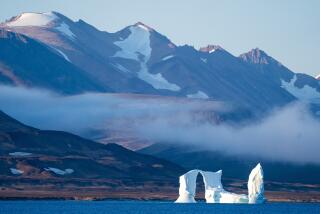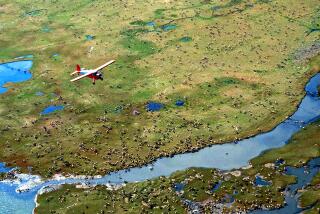Crossing the Arctic in a rowboat: They plan to be the first
- Share via
They’re calling it the Arctic Row. Four men with a profound love of adventure are setting out to do something dangerous and unprecedented -- something they could not have done before the ice covering the top of the world began to melt in earnest.
They are going to row across the Arctic Ocean, nonstop and without support.
It’s just four U.S. men in a narrow rowboat -- but they have a gigantic issue before them: what the melting of the Arctic means for the world. Obviously, they won’t come away with all the answers. What they say they’re looking for, at the very least, is to raise a little more awareness about the changes underway in the Arctic.
PHOTOS: The team, the boat, a whale nose
Promoters of the voyage have billed it as “one of the world’s last great firsts.”
The four rowers -- Paul Ridley, Collin West, Neal Mueller and Scott Mortensen -- plan to board their 29-foot-long, 6-foot-wide rowboat on July 15 and spend the next 30 days aboard the craft, taking turns rowing, two at a time, for two-hour shifts, 24 hours a day.
The boat is equipped with a desalinator to convert 400 pounds of saltwater each day into 24 liters of drinking water. Solar panels on the cabin of the boat will provide power for a VHF radio and a navigation system, as well as a laptop -- the team plans to tweet.
Neal Mueller, in an interview Monday with the Los Angeles Times, said of the planned day-to-day routine: “Basically, you’re sleeping and rowing.”
But the team will also have to make time for eating, navigating and “tweeting like crazy” -- as well as collecting data in conjunction with scientists from the University of Alaska, Fairbanks.
Not to worry. The four men behind the oars are nothing if not overachievers.
The team: Runners, rowers, racers
Ridley is a long-distance rower who in 2009 became, at age 25, the youngest American ever to row solo across the Atlantic Ocean. It took him 87 days to make the 2,950-mile trip, which was to honor his deceased mother and raise money for cancer research.
West, like Ridley, has an MBA from Northwestern’s Kellogg School of Management. He’s also an adventure racer, having won the Texas State Championship Adventure Race Series, a competition that can include mountain biking and trail running.
The rowers aren’t shy about bragging on one another’s behalf. In an interview Monday with the Los Angeles Times, Mueller and Mortensen said, with tongue slightly in cheek, that -- of the four of them -- West was “the best looking and most likable” and soon to marry a Dallas Cowboys cheerleader, to boot.
Mueller has swum the English Channel and was the 120th person to climb all of the seven summits -- the highest mountains of each of the seven continents -- which he accomplished in three years (“I got lucky with the weather,” he said).
Mortensen climbed Mount Everest, as did Mueller. “But when Scott climbed Everest,” Mueller said, “he did it with a really heavy backpack filled with camera gear.” Mortensen counts filmmaking among his pursuits.
On the Arctic trip -- which will begin in Invuik, Canada, and is to end 1,300 miles later in Provideniya, Russia -- Mortensen will make use of his paramedic training, acting as the team’s medical officer.
The trip is being bankrolled partially by individual and corporate donations, which Arctic Row is soliciting on its website. Help from Eddie Bauer includes clothing for the trip as well as PR.
This trip is special, the rowers said, because it’s uncharted territory.
“There’s no guidebook for rowing the Arctic Ocean,” Mueller said. “It’s uncharted in terms of adventure ... also in terms of safety.”
“It’s just tremendously challenging,” Mortensen said. He’s worked full time for the last six months, he said, trying to be prepared for any eventuality, pondering the small details -- what bearings to use on the rowing seats -- as well as what emergency equipment can be fit into their very limited space, “in case it hits the fan.”
“I think the rowing is going to be the easy part,” Mortensen said. “The hard part is to raise the collective awareness and get people to care.”
As the drilling begins
Arctic Row, notably, is scheduled to launch on the same day that a U.S. oil giant is set to begin drilling exploratory wells in seas north of Alaska.
Shell gained U.S. government permission to drill five exploratory wells in the Arctic Circle beginning in mid-July, to the horror of some environmental groups. The wells will be drilled in the Chukchi and Beaufort seas north of Alaska, beginning July 15, according to Scientific American.
Greenpeace already has begun some in-your-face tactics, including “shadowing” Shell’s drilling vessels.
Mueller said the small party of rowers doesn’t plan to make waves: “We’re just going to row by.”
Expanded oil exploration is just one among myriad effects of climate change in the Arctic. Shipping routes are multiplying. Ten freighters went through the region in 2010, Mortensen said, 34 last year, and 100 are expected to pass through what is becoming an ice-free shipping route in summers.
Mortensen noted with some irony that the shipping routes “save on the carbon footprint,” drastically cutting the distance ships have to travel.
Russell Hopcroft, a well-known marine biologist from the University of Alaska, Fairbanks, explained in an email interview with The Times that the Arctic Ocean will continue to be covered by ice for most of the year, although that ice is “younger” than it was in the past. But scientists predict “that we will hit conditions where the Arctic Ocean may be virtually ice-free during summer by the middle to end of this century.”
“Functionally, we are now far enough along that projection,” he said, “that commercial shipping through the Arctic’s margins during late summer ... is now possible.”
An ice-free Arctic Ocean will “almost certainly” affect weather at high latitudes, he added, “we just don’t yet understand how it will and how far south the impacts will reach.”
As shipping routes open up, blossoming industry could radically change the lives of people who live in the Arctic, Mueller said, many of whom now live in poverty.
The silver lining, however, begins to look thin when weighing environmental effects.
“What you’re looking at is a climate and a place where there’s very little wiggle room for error,” said Julie Hagelin, senior research scientist at the institute of Arctic Biology at the University of Alaska, Fairbanks.
Animals in the Arctic are highly adapted to extreme climates, Hagelin explained in an interview Tuesday with The Times. Warming temperatures mean life-threatening loss of ice, loss of snow, constriction of animals’ range of habitat, changes in the time that breeding occurs and more.
Winners and losers
Hopcroft said: “Like change everywhere, there will be winners and there will be losers. Species that are dependent on the sea ice are likely the biggest losers, and species that do better without heavy ice are likely the biggest winners. ... Species that normally live outside the Arctic will move further into it seasonally, but because the ocean will still become cold and ice covered each year, they will either need to move out seasonally or will die if they cannot get out.”
Loss of animal species, Hopcroft said, may be considered a philosophical tragedy for humans globally, “but to those who live in the Arctic and are dependent on its resources for subsistence, ongoing changes may become a disaster.”
Adding to the human disturbance, some Alaskan villagers have been displaced as loss of sea ice has increased erosion of land, and the ground under their feet has become unstable as the permafrost has begun to thaw.
CNN reportedin 2009 on the native village of Shishmaref. At the time, one house had toppled into the ocean, and 13 others were moved inland; the land on which they stood washed away.
“People are really struggling up here -- animals and humans alike,” Hagelin said.
Experts on climate change have reported that globally the rise in the sea level from the melting of Arctic ice could, among many other detrimental effects, displace many who live on the world’s coasts.
The Times noted in an editorial Tuesday that a new U.S. Geological Survey has found sea levels rising more quickly along the East Coast from Massachusetts to North Carolina than they are globally, bringing the threat of catastrophic flooding, damage to ports and airports and inundation of low-lying towns.
And that’s just the tip of the melting iceberg.
But amid the doom and gloom, Hagelin said, an expedition like Arctic Row is a bright spot.
In our future: Whale herding?
As the four adventurers test their endurance, they’ll also be doing some experiments and observation for Hagelin and Hopcroft.
It’s research that touches on the dire future of the Arctic -- but also stirs up some imaginative possibilities; for instance, could we someday herd whales the direction in which we’d like them to go, such as away from an oil spill?
For Hopcroft, the team will collect data on plankton in the Arctic Ocean.
“We have a large net we cast overboard two times a day,” Mueller said, “to measure plankton content in this newly unfrozen ocean.”
The Arctic Row route will help connect several areas in the Chukchi and Beaufort seas that Hopcroft’s lab is working on, the biologist said. Their samples will help him to establish the abundance and types of zooplankton -- which form the basis of the entire marine food chain -- there are in the region through which they will row.
For Hagelin, the rowers will be trying to help determine whether “whales use their noses to find food.”
“They’ll be looking at wind direction and wind speed, recording every whale they see and determining the heading of the whale,” she said.
Heading into the wind is consistent with the idea that baleen whales could be using odors they smell to orient in the open seas, she said. This could help explain how filter-feeding whales such as the humpback whale find their food.
“They’re hunting for the the needle in the haystack,” she said, “going after very ephemeral moving hatches of krill, which seem to us scattered about unpredictably in a visually featureless ocean.”
Then there’s the possibility that whales use odors -- secretions, perhaps -- as one way of communicating. (Anyone who works with whales, she noted, knows that whale breath smells exceptionally bad.)
Among other hypotheses is that odors that are a natural marker of a site rich in phytoplankton could be used to lure whales, steering them away from problem areas, such as an oil spill.
“And much like humans to smell of bacon,” Mueller said, “they will come.”
That’s the theory, anyway. Hagelin said it’s still “highly speculative.” But currently, she said, the only way people have of getting whales out of a problem area is by harassing them.
“If we could understand cues that whales use that would perhaps motivate them to follow us and move from one area to another, say if there was an extreme hazard like an oil spill, that would be an extremely powerful tool that might get animals out of harm’s way.”
Arctic Row is going to help set up further research into such areas, though -- and at a great bargain for the scientists.
The rowers are gathering key scientific data, she said, in a pristine environment.
“We’d be crazy to forgo this opportunity; it’s free data for us,” Hagelin said. “It’s more than we would be able to do on our meager budgets.”
ALSO:
Forest Service chief: July 4 brings additional risks
July 4 is deadliest day on roads; 10% of fatalities are teens
All-American flags? U.S. flags should be made in the U.S., some say
Join Amy on Google+. Email: [email protected]
More to Read
Sign up for Essential California
The most important California stories and recommendations in your inbox every morning.
You may occasionally receive promotional content from the Los Angeles Times.











